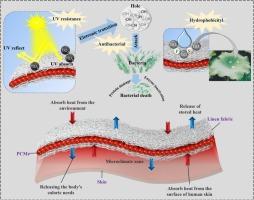多功能亚麻纤维素织物涂料:集蓄热、调温、疏水性、抗紫外线、抗菌性能于一体
IF 6.1
2区 材料科学
Q1 MATERIALS SCIENCE, COATINGS & FILMS
引用次数: 0
摘要
近年来,功能性热调节织物已成为纺织工业研究和开发的一个重要领域,引起了广泛的关注。采用核壳乳液聚合法制备了十二烷基醇/石蜡-苯乙烯-丙烯酸酯乳液(DD/PW-TiO 2 /FSiWSA),并将其用于亚麻织物的整理。为解决水基苯乙烯-丙烯酸乳液(WSA)固含量低、稳定性差、耐水性差的问题,首先采用3-甲基丙烯氧基丙基三甲氧基硅烷(KH-570)对纳米二氧化钛进行了改性。随后,KH-570修饰的纳米二氧化钛和有机氟硅同时被引入聚合物骨架中。研究了DD/PW-TiO 2 /FSiWSA的结构特性。结果表明,DD/PW-TiO 2 /FSiWSA涂层使亚麻织物的水接触角(WCA)从0°提高到131.95°,同时具有优异的耐污性。改性织物具有优异的抗紫外线性能,紫外线防护系数高达56.16。此外,改性织物对黑曲霉和金黄色葡萄球菌具有良好的抗菌活性。令人鼓舞的是,改性后的织物具有优异的储热和温度调节能力,其峰值相变温度为23.6℃,熔化潜热为25.36 J/g,导热系数提高了65.9%。该涂料具有通用性,可增强棉织物、涤棉、纸张、纸板、木材等材料的疏水性,WCA范围为115.56°~ 131.72°。因此,这种多功能涂层将引领纤维素材料走向多样化的应用。本文章由计算机程序翻译,如有差异,请以英文原文为准。

Multifunctional linen cellulose fabric coating: Combined heat storage and thermoregulation, hydrophobicity, UV resistance and antibacterial properties
Functional thermoregulation fabrics have emerged as a significant area of research and development within the textile industry, garnering extensive attention in recent years. Herein, dodecyl alcohol/paraffin wax-styrene-acrylate emulsions (DD/PW-TiO₂/FSiWSA) were prepared using the core-shell emulsion polymerization method and used for the finishing of linen fabrics. To address the issues of low solid content, insufficient stability, and poor water resistance in water-based styrene-acrylic emulsions (WSA), nano-TiO₂ was first modified with 3-methacryloxy propyl trimethoxysilane (KH-570). Subsequently, KH-570 modified nano-TiO₂ and organic fluorosilicon were simultaneously introduced into the polymer skeleton. The structural characteristics of DD/PW-TiO₂/FSiWSA were studied. The results shows that the DD/PW-TiO₂/FSiWSA coating increases the water contact angle (WCA) of linen fabric from 0° to 131.95°, while also providing excellent stain resistance. The modified fabric has excellent anti-UV properties, and the UV protection factor is as high as 56.16. Moreover, the modified fabric exhibited excellent antibacterial activity against A. niger and S. aureus. Encouragingly, the modified fabric has excellent heat storage and temperature regulation capability, with a peak phase transition temperature of 23.6 °C, a latent heat of fusion of 25.36 J/g, and a 65.9 % increase in thermal conductivity. The coating is universal and can enhance the hydrophobicity of materials such as cotton fabrics, polyester cotton, paper, cardboard and wood, with a WCA range of 115.56° ~ 131.72°. Therefore, this multifunctional coating will lead cellulose materials towards diverse applications.
求助全文
通过发布文献求助,成功后即可免费获取论文全文。
去求助
来源期刊

Surface & Coatings Technology
工程技术-材料科学:膜
CiteScore
10.00
自引率
11.10%
发文量
921
审稿时长
19 days
期刊介绍:
Surface and Coatings Technology is an international archival journal publishing scientific papers on significant developments in surface and interface engineering to modify and improve the surface properties of materials for protection in demanding contact conditions or aggressive environments, or for enhanced functional performance. Contributions range from original scientific articles concerned with fundamental and applied aspects of research or direct applications of metallic, inorganic, organic and composite coatings, to invited reviews of current technology in specific areas. Papers submitted to this journal are expected to be in line with the following aspects in processes, and properties/performance:
A. Processes: Physical and chemical vapour deposition techniques, thermal and plasma spraying, surface modification by directed energy techniques such as ion, electron and laser beams, thermo-chemical treatment, wet chemical and electrochemical processes such as plating, sol-gel coating, anodization, plasma electrolytic oxidation, etc., but excluding painting.
B. Properties/performance: friction performance, wear resistance (e.g., abrasion, erosion, fretting, etc), corrosion and oxidation resistance, thermal protection, diffusion resistance, hydrophilicity/hydrophobicity, and properties relevant to smart materials behaviour and enhanced multifunctional performance for environmental, energy and medical applications, but excluding device aspects.
 求助内容:
求助内容: 应助结果提醒方式:
应助结果提醒方式:


